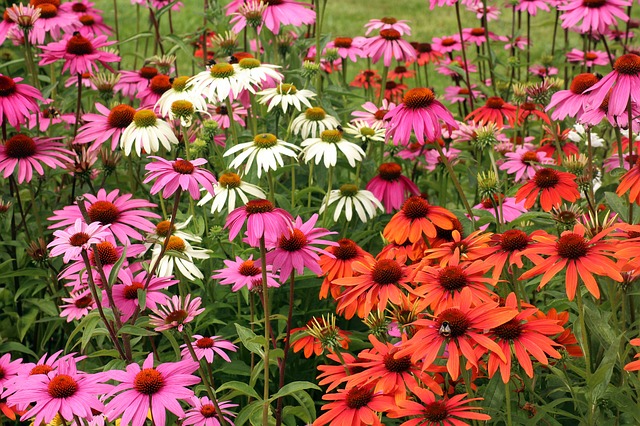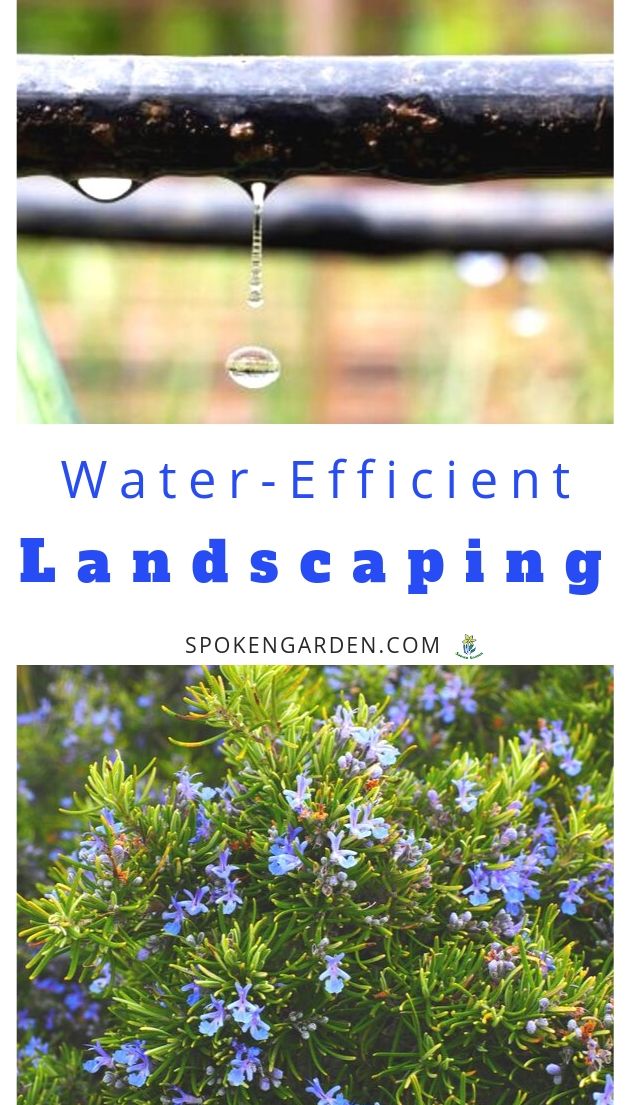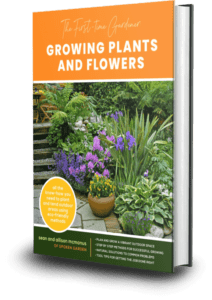Water-efficient landscapes are eco-friendly and look beautiful too! Learn how to create a more water-wise garden you can feel good about with our suggestions!
It’s time to upgrade your landscape.
You’ve been thinking about taking the steps necessary for a while and you’re finally ready to create a more water-efficient landscape that is easier to maintain and uses less water overall. Because, you want your little slice of heaven to look pretty but you also want to help protect Earth’s natural resources.
Luckily, there are so many actions you can take to upgrade your current yard! From water-saving products to microclover to drought-tolerant plants to watering timers, you’ll find an option that suits your needs and your style below. Plus, you’ll feel great knowing that you’re creating a beautiful environment that is pollinator-friendly and way more ecofriendly than your old yard or garden.
In this podcast (and on the page below), learn about six of our favorite drought-tolerant, water-wise landscape suggestions, tools and supplies you may need to get started, and resources to help you begin this journey of a yard transformation!

In “Using Water-Efficient Landscaping to Save You Time and Money” – Ep. 39 – learn about six different options for water-wise landscapes. This episode is meant for any gardener wanting to create or learn more about eco-friendly, drought-tolerant gardening.
Read on to learn about how to enhance your landscape or jump to the section you need:
- Plant Drought-Tolerant Plants
- Add Compost or Mulch
- Prevent Soil Evaporation
- Perform Deeper Watering
- Use Water-Saving Tools
- Alternatives to Your Lawn
- Videos for Water-Saving Ideas
- Books for Water-Wise Landscaping
- Drought-Tolerant Tools and Supplies Kit
Water-Wise Yard Maintenance
Water is a precious resource. We only have so much of it and the only free water we get is in the form of rain. Otherwise, you have to use water from your municipality which costs money.
Why not lower your monthly water bill and save time and energy by learning how to enhance your current landscape?
Below are six ideas or steps you can take to enhance your yard into a more water-efficient landscape today! Read on below to learn more!
1) Plant Drought-Tolerant Plants
The first step on your journey of water-efficiency is to fill your landscape with drought-tolerant plants such as Rosemary, Lavender, Black-Eyed Susan, Yarrow, and many more.

Coneflowers are low maintenance and drought-tolerant
This is perfect for you if you desire a colorful landscape full of texture but with lower maintenance and less overall water use! By adding native, drought-tolerant plants, you’ll enhance your environment
In addition to plants already mentioned, drought-resistant ornamental grasses also require little watering, no fertilizing and love the sun. Easy, breezy. Keep in mind it’s important not to overwater ornamental grasses. Try attaching a drip hose and sprinkler to a water timer so you can regulate the amount of water distributed.
There are several beautiful perennials, groundcovers, and grasses you could add that can sustain low levels of water for many weeks at a time.
Drought-tolerant plants are not unattractive or colorless. There are so many sizes, shapes, and colors available it really is just a matter of your preference. Adding any one of these plants below to your landscape could beautify your yard or balcony while helping save precious water.
Here are a few of our favorites with links to buy them now:
- Lavender
- Yarrow
- Rosemary
- Russian Sage
- Purple Coneflower
- Black-Eyed Susan
- Blanket Flower
- Coreopsis
- Purple Fountaingrass
- Allium
2) Add Compost or Mulch
Make your yard more water-efficient by adding compost, organic matter, or mulch into your soil.
By doing this you will accomplish at least two things:
1. Increase your soil’s ability to hold more water for longer periods of time.
2. Add nutrients to the soil to keep your plants healthy, along with any beneficial soil organisms, too.
3) Prevent Soil Evaporation
Part of making your yard more water-efficient is reducing the water evaporation from the soil.
One way to achieve this is to add or replenish your mulch to keep your plant’s roots cool. Also, mulching will help retain more moisture and decrease evaporation caused by sun and air movement.
4) Perform Deep Watering
What is exactly is deep watering? Deeper watering will help to stimulate deeper root growth in your lawn and yard areas.
When irrigating, water for longer periods of time irregularly or not on a set schedule so water can theoretically get deeper into the soil to be held longer and be more readily available.
5) Use Water-Efficient Tools
Various garden tools can help you accomplish your drought-tolerant goals. There are so many ways to alter your landscape in order to use less water as well as less of other resources. Luckily, there are also several tools, supplies, and books that can help! For example, this water timer is a great tool for your eco-friendly landscape. By setting the timer to the length or frequency you want, you’ll save time and money on precious resources and bills.
We love our Orbit water timer and we feel good knowing that we only use water as needed. It’ll help you monitor the time your water is running and therefore lessen the amount of water that is used. Plus, you can set the timer for when it goes off!
Pick yours up today at the link below! (They also have timers with only one hose attachment or as many as three).
Other Recommended Supplies:
Gilmour 75′ soaker hose (or drip hose)
You’ll need some type of garden hose for your plants and this is one of the highest-rated on Amazon from Flexzilla. It is flexible, durable, and comes in multiple lengths for whatever size your yard.
RTS Rain collection barrel
6) Lawn Alternatives
Have you ever wanted to make a BIG change somewhere in your landscape that you weren’t sure would work?
Well, this past winter we did something crazy. We decided to follow through on one of our (many) yard renovation projects and tore out our whole front lawn! It was unattractive, hard to keep green, and required a lot of maintenance.
All the neighbors thought we were nuts because everyone on our street has nice, green lawns that also require a ton of upkeep including watering, fertilizing, mowing, etc.
We knew we wanted to eliminate all the water, time, and effort spent trying to keep our lawn healthy so instead, we created a front yard garden!
We filled our new water-wise landscape with drought-tolerant herbs, low-water perennials, gravel, and started growing tons of food. As it turns out, our neighbors love our new front yard renovation and stop by all the time to chat about it!
In addition, this fall we plan to re-seed our backyard with this microclover seed from Nature’s Seed (see below for more on this seed) to further improve our low-water, eco-friendly garden goals.
These are just a couple of ideas for lawn alternatives that you could use to replace your traditional lawn.
Examples of lawn alternatives:
- Microclover
- Creeping thyme
- Irish mos
- Mulch
- Drought-tolerant plants
- Xeriscaping
- Ornamental grasses
- Synthetic, artificial turf
- Stonecrop
This fall we plan to re-seed our backyard with this microclover seed from Nature’s Seed to further improve our low-water, eco-friendly garden goals.
Microclover is a small variety of White Dutch Clover seed that has been bred to have smaller leaves. It can be used as a standalone, groundcover or as a lawn seed mix to use with your existing lawn which is how we intend to use our microclover seed. It would be best added in the fall or spring and will establish quickly.
In addition, this clover can also be used as a cover crop in your raised garden beds because it fixes nitrogen in the soil. Basically, it acts as a self-fertilizer. This characteristic helps it stay green all year with very little maintenance required. You can mow it, but you don’t have to. Plus you never have to fertilize!
There are so many beneficial reasons to use microclover. Below are some of its many benefits.
Benefits of microclover:
- Stays green all year (due to the nitrogen-fixing in the soil).
- Great for pets because it can tolerate pet urine.
- Safe for kids because it can be stepped on.
- Low-growing and doesn’t flower often so fewer bees (compared to other clovers).
- Light watering required.
Book Suggestions
If you’re anything like us, you love to read and learn more information. Below are a couple great resources for you to further your education with links to purchase them now. We hope they are helpful!
Waterwise Plants for Sustainable Gardens: 200 Drought-Tolerant Choices For All Climates
Lawn Gone!: Low-Maintenance, Sustainable, Attractive Alternatives For Your Yard
Videos for Water-Saving Ideas
In order to help you make your decision and also present other alternative options for a traditional lawn, check out these two videos below. We hope they are helpful!
Conclusion for Drought-Tolerant Lawns
As we continue to see changes to our climate, water is becoming a more precious resource every year. There are so many ways to alter your yard and garden in order to use less water. With so many eco-friendly options available, it has never been easier to make the switch.
Adding microclover, drought-tolerant plants, or watering deeply are great enhancements to consider. Plus, using various tools like this Orbit water timer can help you save water and money so that’s also a huge bonus!
Now we want to hear from you!
What questions do you have about any of the water-wise options we’ve discussed or other ideas, not on our list? Let us know by leaving a quick comment below. Thanks!
Drought-Tolerant Lawn Alternatives References:
- “Landscaping Tips” – United States EPA
- “Principles of Water-Wise Landscaping” – Utah State University Extension
- “Drought-Resistant Landscaping Ideas” – SFGate
- “Xeric-, Water-Wise, Drought-Tolerant: What Does It All Mean?” – Sunset Magazine
That’s all for this DIY garden minute episode!
You can find other one-minute topics on our podcast page at spokengarden.com/podcast
Find us on Instagram or Pinterest to follow or leave us a comment. We would love to hear from you!
Also, find us on your favorite podcast platform and Alexa through MyPod or AnyPod.
And hey—before you head out—if you want to connect with us and subscribe to our newsletter go to Spoken Garden’s free resource page!
We have FREE garden content we are so excited to give to you, like cheat sheets, plant profile sheets, etc!
Thanks for Listening!!!
Share Your Thoughts:
- Leave a note in the comment section below.
- Leave comments/ suggestions at Seanandallison@eseospace.dev
- Share our show on Twitter, Facebook, or Pinterest.
To Help Out The Show:
- Leave a review on iTunes. Your ratings and reviews really help us out!
- Subscribe on iTunes or Spotify.

Click the graphic above to save “Water-Efficient Landscaping” to Pinterest for later!
*Spoken Garden is a participant in the Amazon Services LLC Associates Program, an affiliate advertising program designed to provide a means for sites to earn advertising fees by advertising and linking to Amazon.com.
Water-efficient landscapes are eco-friendly and look beautiful too. Learn how to create a water-wise garden you can feel good about with our suggestions!
Subscribe on iTunes
Today’s Topic:
Water-Efficient Landscaping
In this podcast, you’ll hear about six water-efficient landscaping ideas that will save you time and money. Implement any of these ideas in your water-wise garden.
Downloads:
Free Fall Season Gardening chapter from our ebook, Four-Season Gardening.
Clover free plant reference sheet (from our free resource library)
What You’ll Learn:
- Water-efficient ideas for your drought-tolerant landscape.
- Recommendations for landscape plants to purchase.
- Links for further resources or education.
Resources:
Some of the resources and products below may be affiliate links, meaning we might get paid a commission (at no extra cost to you) if you use that link to make a purchase.
- Lawn Alternatives for Your Drought-Tolerant Landscape – DIY Garden Minute Ep. 106
- Drought-Tolerant Plants and Why They’re Beneficial for Your Low-Water Garden – Ep. 37
- Blanket Flower: Gardener’s Guide and Plant Profile
- Drought-Tolerance Defined – DIY Garden Minute Ep. 104
- Drought-Tolerant Perennials That Bloom All Summer -DIY Garden Minute Ep. 97
- Eden Brothers 15% off coupon for Spoken Garden listeners
Other Gardening Products Related To This Podcast You Might Not Have:
- Drought-Tolerant Supplies Kit
- Microclover
- White Clover Cover Crop
- Orbit Water Timer
- Gilmour Soaker Hose
- RTS Rain Barrel


